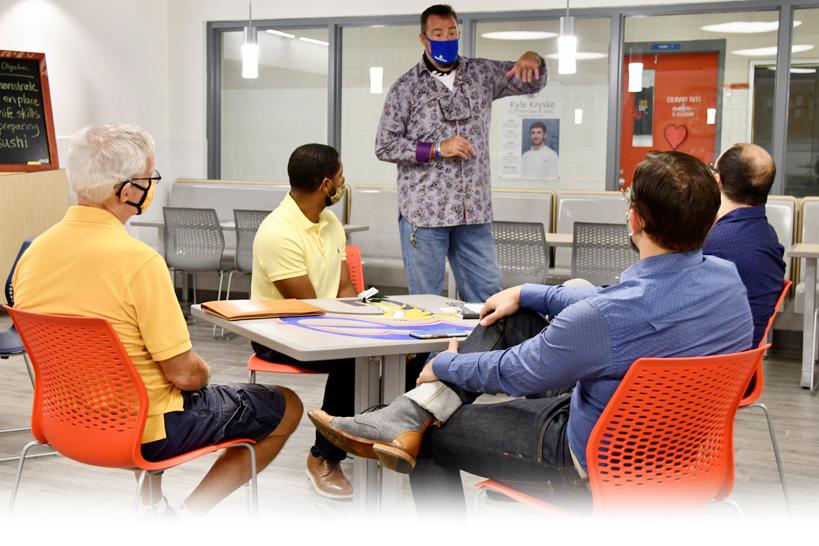
4 minute read
Readying First Responders
FIRST RESPONDERS
Hattiesburg LPS Supplement Program Trains Future EMTs
Brock Turnipseed
When the ambulance pulls up to a medical emergency, the first responders who jump into action performing life-saving actions could be students from Hattiesburg High School’s (HHS’s) law and public safety (LPS) program.
Six students in the program enrolled in a supplemental course designed to help them earn their emergency medical technician (EMT) certification.
The EMT course, offered through Advanced Rescue Education Solutions (ARES), is a hybrid format of virtual classroom instruction and hands-on skills training.
Sherod Reed, HHS LPS instructor, said the online portions of the course take place in the evening, but the students can watch recordings of the classes if they are absent.
Two of his students have already completed the Emergency Vehicle Operator Course and are licensed to drive an ambulance. Once they complete the ARES course, they will be able to take the national registry and earn an EMT-Basic certification that will allow them to work as an EMT or continue training to be-
come a paramedic.
Reed first discovered ARES when looking for a program for his daughter and realized it could benefit high school students looking to make the LPS field their career or to work as an EMT while furthering their education.
Reed said the EMT course gives them a pathway to a rewarding career and allows them to gain a different perspective toward human life.
“They are realizing that being an EMT means you are responsible for another human. It gives them a different sense of responsibility and accountability. They get a chance to take care of their fellow man. That’s one of the best things about doing what we do,” said Reed, a fire, law enforcement and medical first responder.
Because of the responsibilities associated with the EMT field, ARES owner and instructor Robert Roy said the HHS students are held to the same standards despite being the youngest members of the class. This rigorous approach has succeeded: Roy said he has been impressed with their determination and ability to manage this course and their other classes and activities.
“They’re taking a college-level course designed to put them in the workforce,” Roy said. “It’s very fast-paced, and we don’t expect them to be taught at a slower pace.
They’ve done a really good job. Many of (the HHS students) work and are in class, so juggling that time with the course can be difficult for high school students. They’ve impressed me with their time management skills. As a teenager, that’s hard to do, but they’ve done it.”
While it may be challenging, providing the students with the EMT certification sets them up with the school’s vision of having students college or career ready in a high-demand profession. Opposite page: Hattiesburg High School (HHS) senior Devin White checks for a potential hip injury during a trauma assessment skills training as part of the EMT program HHS law and public safety (LPS) students are taking. Top: Jackson (second from right) assesses a trauma patient for a hip injury as, from left to right, senior Aaliyah Hales, White and junior McKynlee Rogers look on. Bottom: White (left) takes Hales’ blood pressure as senior Damiyen LeFlore looks on.





Top: Senior Paris Jackson, a senior LPS student, works on assessing a trauma patient during EMT skills training. Students in the program do classroom instruction over Zoom and have hands-on skills training each month. Middle: HHS LPS instructor Sherod Reed (second from left) observes as Hales takes White’s blood pressure. Above: Advanced Rescue Education Solutions (ARES) owner and instructor Robert Roy (right) discusses assessing a trauma patient with White (left) and Hales.
“We want to make sure our students are exposed to these high-demand careers and have an opportunity to get the certifications. I believe that focusing on a career path and the opportunities for students to gain these certifications is going to help with the shortage that these particular areas are facing,” said HHS Career and Technical Education Director Jermaine Brown.
Senior Paris Jackson is one of the students in the EMT course. Although she plans to attend Texas Southern University (TSU) and major in criminal justice with future aspirations of working for the FBI, she said the EMT certification would provide her the skills to work in the field while in school or put into use when an emergency arises.
“You can use these skills to save lives, whether you want to be an EMT or not,” Jackson said. “In our communities we see situations and don’t know basic skills like CPR, so having the opportunity to learn these skills is something everyone should do.”
Jackson said she has enjoyed the course, with trauma being her favorite module.
Seeing the EMT course’s success, Reed aims to offer first-year students the opportunity to take a semester-long Emergency Medical Responder (EMR) course before moving into the EMT course.
Reed sees the EMT course as a tangible way for students to earn certifications and immediately join the workforce, since the minimum age to work in law enforcement is 21.
“I push the emergency medical services, military and fire portions (of LPS) because they can do all three right now,” Reed said. “What I like about these programs and CTE is students come out with certificates and can go directly into the workplace.”










